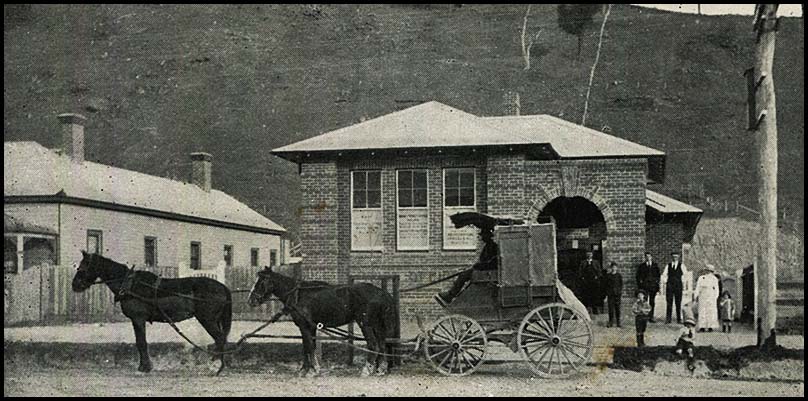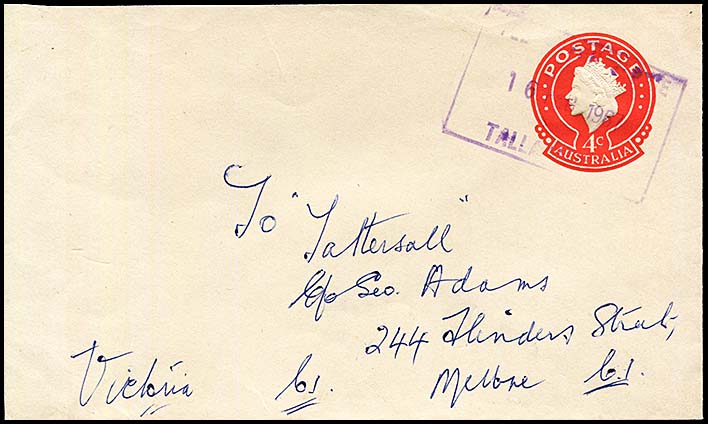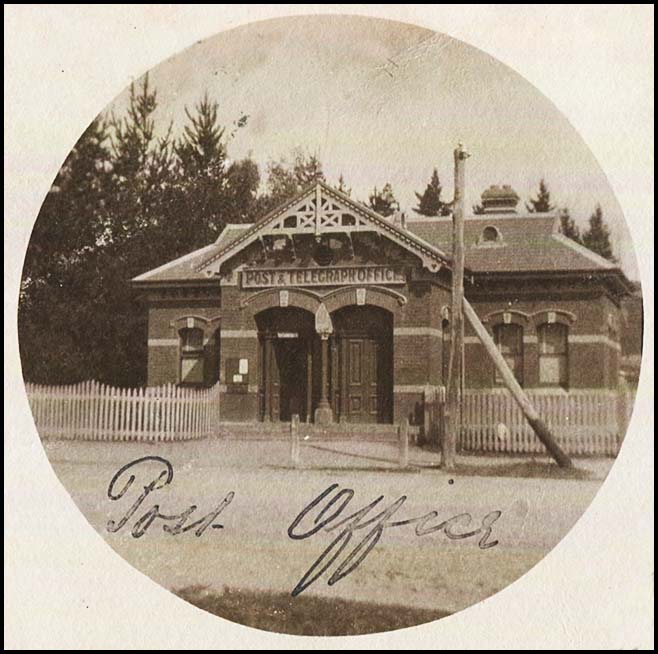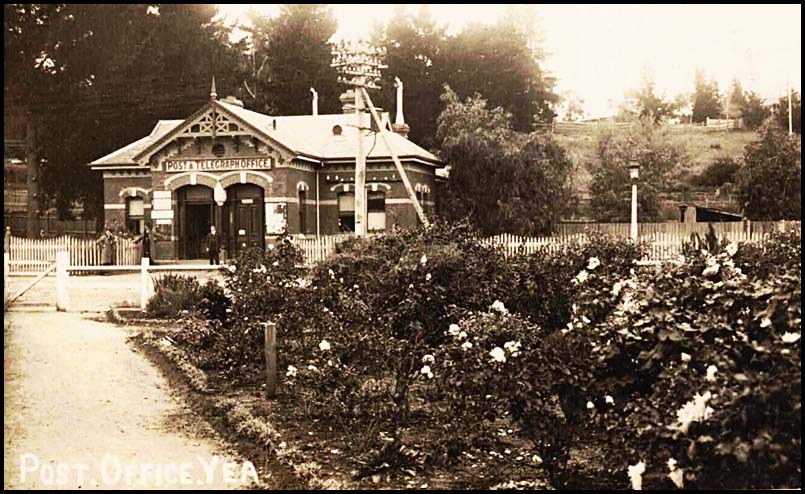Telegraph Offices on the Branch lines from the main Albury line (No. 1 and No. 2 N.E.).
- Australia 1901-1988
- New South Wales
- Queensland
- South Australia
- Tasmania
- Victoria
- Western Australia
- International
- Special aspects
There were three Branch lines associated with the main line constructed to Albury and Wodonga. The following table lists alphabetically all stations on the main line and on the branches. The hyperlinks lead to the appropriate webpage with the information for the required Office. On this page only the Offices on the Branch lines are included.
| Name of Branch | Stations on that Branch | ||||
| Heathcote | Kilmore | Heathcote | Sandhurst | ||
| Tintaldra | Wodonga | Bethanga | Tallangatta | Corryong | Tintaldra |
| Yea | Seymour | Tallarook | Yea | ||
| Reedy Creek | Kilmore | Broadford | Reedy Creek | ||
Bethanga.
|
Reedy Creek. In the 1880s, Reedy Creek was the centre of a rich gold mining area. Excellent reports of the search for gold were common and fairly consistent - for example, on Saturday 1 May 1880, 390 ounces of gold were brought from Reedy Creek to Kilmore - the result of washing 56 tons of stone from the Crown Claim at Reedy Creek. It was often described as "being one of the best paying mines in the Colony". In May 1881, "the mining registrar at Kilmore reports that the yield from the Reedy Creek mines from the 1st January to the 31st March was l,070oz. of gold from 386 tons of stone ... Within the past few months, the returns from Reedy Creek are equal to the best in Sandhurst or Ballarat". In May 1882, the construction of the telegraph line had been completed and so, according to good sequential planning techniques, it was time to consider the location of the office. The Seymour Express reported that, on Tuesday 6 June, "A public meeting was held at Mahony's rooms, Reedy Creek on Tuesday for the purpose of adopting a site for the proposed Post and Telegraph office. There was a large attendance, and considerable local interest was taken in the proceedings. The President of the shire of Broadford, D. L. Ferguson Esq., was voted to the chair on the motion of Mr Maxfield, seconded by Mr Aitken. Mr Pater, an officer from the General Post Office, Melbourne, was also present. Mr. McManus said he considered that the best place for the Telegraph office was at the South end of the township as the population was greater there than at the north end and besides, there were a number of miners in the ranges who would be benefited if this site was selected. Cr. Lonargon quite agreed with the remarks of the last speaker and he considered the south end the most suitable, where the Government township was surveyed. Mr Wallder was in favor of a central site at or near the State School. Mr. Gleeson considered the best place for Government offices was in the township. Mr Maxfield said the residents at the North end were not selfish; all they desired was that, if the Post Office was to be moved from its present position, it should be put in the most central site which was near the new State school. Mr Trezise was in favor of a central site in the vicinity of the new State school. He therefore moved that the inhabitants of each end of township choose a site and a ballot be taken in order to adopt one. Mr Gleeson seconded the motion which was carried. Several other speakers addressed the meeting, subsequently a committee consisting of Messrs Lonargon, Trezise, McManus, Helms, Maxfield, Kerr and Coghill were appointed to carry out the arrangements for taking the ballot on Saturday the 17 inst. Mr D. Ferguson kindly consented to act as Returning officer on the occasion". On 20 June, The Age announced the results of the ballot: Camp Hill - 117 votes; McManus's Hill - 44 votes. On 22 June 1882, The Age noted "A deputation from Reedy Creek waited on the Postmaster-General yesterday and protested against the site selected for the new Post and Telegraph Office. The deputation stated that Mr. Pater, one of the inspectors of the department, who had visited the district to ascertain the most favorable site, had stated that he would be guided in his choice by a vote taken at a public meeting of the residents. A public meeting was consequently held, when three-fourths of the meeting voted for the offices being erected on Camp HillThis was the State School building site. as being the most central position. Notwithstanding this, a contract had been entered into to erect them on McManus's Hill at the extreme end of the township. Mr. Bolton replied that, the contract having been entered into, he could not alter the decision". The Argus of the same day had replaced the last sentence with "Mr. Bolton said that temporary arrangements had already been made for the new offices but, in any future arrangements, the wishes of the residents would not be over-looked". The Seymour Express of 23 June added the interpretation that " the result would have been different had the day been fine as then the miners from the east would have numbered in force. Even now it is thought the polling will result in a bottle of smoke, the Government having leased premises for three years. (The Postal authorities refuse to abide by the voting, having leased premises)". Finally the Kilmore Free Press of 29 June reported its interpretation: "Occasionally I visit the Reedy to have a glance at the mines and see is there any money to be made. When on the spot the other day, I found the place was stirred to its very centre - a poll being taken as to whether the Camp Hill or Mac's Hill should be chosen for the Post and Telegraph Office site. The adherents of the former place gained the victory by a large majority and no doubt every respect will be paid to such decision when the Government will be erecting offices of their own. But I understand it has been determined to accept an offer for a temporary office near McManus's and that the public will soon be able to transmit messages to and from Reedy Creek. I am sure, apart from the questions of office site, the whole of the inhabitants should feel grateful to the postal authorities for providing telegraphic accommodation". The Telegraph Office was opened for sending messages on 16 October 1882 with the Bendigo Advertiser reporting this on 17 October. On 12 October 1882, the Kilmore Free Press had reported "Mrs Bourke, for many years assistant in the Kilmore Post and Telegraph Office, has received well earned promotion and has taken charge of the new office at Reedy Creek". As an aside:
|
|
| The Office was issued with a Belt & Buckle date stamp which was used in black from 1 November 1888 to November 1893. | 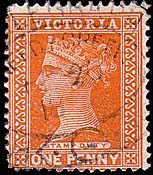 Reedy Creek: 1 hole in black. Rated RRRR Provenance: Hugh Freeman. 27 × ? mm. |
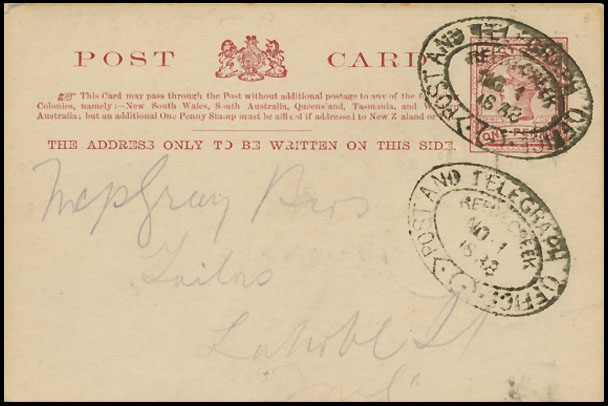 Two complete strikes of the Belt & Buckle date stamps of 1 November 1888 on postcard. Prestige Auctions October 2010 Lot 352. |
|
| Tallangatta. On Tintaldra Branch. A Telegraph Office was opened on 10 November 1884 on the Tintaldra branch line was extended from Wodonga. On 7 January 1882, the Ovens and Murray Advertiser reported: "At the close of the meeting of the Towong Shire Council on Tuesday last, some discussion took place amongst the members of the council and several local residents with regard to the extension of the telegraph system to Tallangatta. Mr. A. Paton said it was understood that the Government would extend the telegraph to Tallangatta if receipts to the amount of £120 per annum were guaranteed. Several who were present, including Mr Paton, Mr Dyring, Mr Francis and one or two others, expressed their willingness to guarantee £10 each and it was decided, says the Albury Banner to take steps to obtain the remainder of the guarantee required with a view to securing the construction of the line with as little delay as possible".
|
|
| In 1883, the Government had undertaken "to favourably consider a request for the extension of the electric telegraph to Tallangatta, on the Upper Murray". On 1 July 1898, the Taralgon Record noted "the tender of Mr. J. Peterkin has been accepted by the Post Office for the management of the Tallangatta Post and Telegraph Office for a period of five years".
In September 1908, "Miss Peterkin, who has been in charge of the local post office for the past three months, has been relieved by Miss Mangan, who will be now in charge of the Tallangatta Post and Telegraph office. Miss Peterkin will be seeking fresh fields and pastures new and all with whom she came in contact wish her success in her new sphere" (Wodonga Express, 18 September). On 18 December 1913, the Border Morning Mail carried the story that "The new post and telegraph offices at Tallangatta have been taken over, and the staff is now installed in the new quarters. The building is of brick, and is a handsome and commodious structure, fitted with the most up-to-date requirements". More information of the Tallangatta Telegraph Office and the extension of the line to Cooryong and Bethanga is provided elsewhere. |
The Office was issued with a rectangular Telegraph Office date stamp (RR2 - TO) for use with telegraphic matters. Two formats are know - the main difference being size.
|
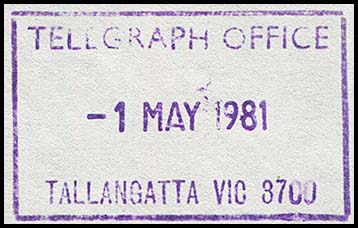 1 May 1981. |
|
|
A Telegraph Office was also opened for some time at the Tallangatta Railway Station. The station was issued with a rubber circular date stamp (RC2) with the inscription VR.
|
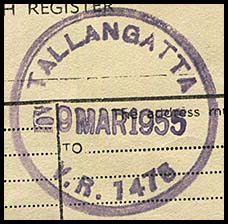 9 March 1955. Struck in purple. Only example recorded. |
The area can be dangerous if one is a Telegraph Line repairer. The Border Morning Mail of 30 September 1910 carried the following story: "Mr. Sheppard, telegraph line repairer had a sensational experience near Tallangatta on Tuesday night. He was returning from Berringama in a buggy drawn by a pair of horses driven by Mr. Jas. Madden, employed by Crawford and Co. at the local livery stables. The evening was very dark and, when entering Newtown, the driver mistook the road, and drove over a bank about 8 feet deep. The buggy was overturned and both men were pinned underneath. The noise was heard by Mr. Jas. Grant, who lives close by. Mr. Grant hurried to the assistance of the unfortunate travellers and quickly released them from their dangerous position. Mr. Sheppard escaped unhurt but the driver was badly bruised and shaken. The buggy was damaged but, on the whole, things might have been much worse, and the occupants are to be congratulated on their escape from which could easily have been a very serious accident". |
|
|
A Telegraph Office was opened at the Railway Station in November 1877. Tallarook was on the North-Eastern Railway.
|
|
The Alexandra and Yea Standard published good news on 1 March 1879: "We observe that Mr Knight, the line repairer, has been at work erecting new telegraph posts from Grant Street through Nitle Street to the Public buildings and adjusting the wires etc. thereto. The apparatus has also been removed from the old post office to the new premises, the entire work having been done by Mr Knight in a most satisfactory manner and in a very short space of time. The men employed by him cannot, we assert, be blamed for using what is called "the Government stroke" in their operations. The business of the Post and Telegraph departments will now be conducted in the new public buildings". The Age of 2 March 1870 reported a local (non-telegraph) problem: "Power, the bushranger, has again made his appearance and this time within ten miles of Yea where, on Friday last, he was daring enough to stick up a mounted trooper named Michael Tighe, who was proceeding from Broadford to Yea (the same route as the telegraph would follow). About 1:00 p.m. the trooper was between King' Parrot Creek and Yea, within ten miles of the latter place, and was leading two horses. He had occasion to pass very close to a brush fence when, hearing a voice calling out to him to stop, he looked up and saw a man with a double-barrelled gun levelled at him. The man (who is identified as Power), said, 'If you move I will blow the contents of this through you' and ordered him to give up his Colt's six-barrelled revolver, valued at £7. After taking the revolver, he again levelled his gun at the constable and was evidently about to fire saying, 'I will shoot some of you police, as they are pressing me very hard. Two of them pursued me very close last night'. He then put the revolver in his belt, where he already had two. Another man named Farquhar McKenzie was coming up at the time, he took from him his horse, saddle and bridle, and rode off in the direction of the Upper Goulburn or Plenty Ranges. The two men do not appear to have offered any resistance, but allowed Power to help himself to anything he wanted". |
|
No special date stamp was issued to Yea for use with telegraphs. The ordinary Post Office datestamp was used. |
.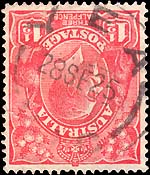 28 September 1925. |
